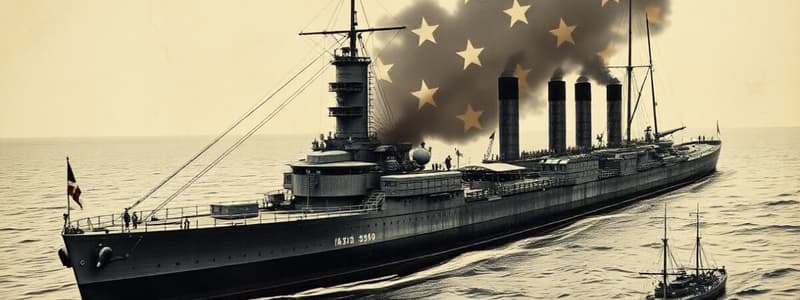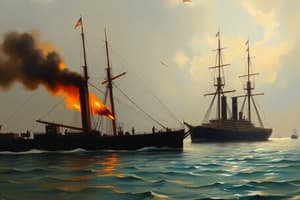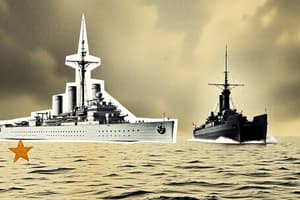Podcast
Questions and Answers
Fearing an uprising at the start of the war, Commodore Charles McCauley ordered the Gosport Navy Yard, today the ______ Navy Yard, burnt to not let war supplies fall into Confederate control.
Fearing an uprising at the start of the war, Commodore Charles McCauley ordered the Gosport Navy Yard, today the ______ Navy Yard, burnt to not let war supplies fall into Confederate control.
Norfolk
The hull of the USS ______ was significantly damaged, however the Confederates refloated the hull and prepared designs for its transformation.
The hull of the USS ______ was significantly damaged, however the Confederates refloated the hull and prepared designs for its transformation.
Merrimack
The Confederate ironclad, formerly the USS Merrimack, was renamed the CSS ______ after its conversion.
The Confederate ironclad, formerly the USS Merrimack, was renamed the CSS ______ after its conversion.
Virginia
The deep draft of the CSS Virginia, measuring 22 ______, was largely due to the weight of the iron plating used for protection.
The deep draft of the CSS Virginia, measuring 22 ______, was largely due to the weight of the iron plating used for protection.
In response to the Confederacy's ironclad plans, the Federals established the ______ board to counter the threat, leading to the rushed construction of the USS Monitor.
In response to the Confederacy's ironclad plans, the Federals established the ______ board to counter the threat, leading to the rushed construction of the USS Monitor.
The USS Monitor was equipped with two 11-inch ______ smoothbore cannons, which were housed inside its rotating turret.
The USS Monitor was equipped with two 11-inch ______ smoothbore cannons, which were housed inside its rotating turret.
On March 8, 1862, the CSS Virginia, accompanied by the CSS Beaufort and CSS Raleigh, sailed to ______ Roads with the goal of breaking the Union blockade.
On March 8, 1862, the CSS Virginia, accompanied by the CSS Beaufort and CSS Raleigh, sailed to ______ Roads with the goal of breaking the Union blockade.
During the initial engagement, the CSS Virginia successfully rammed and sank the USS ______, demonstrating the effectiveness of its ramming capabilities.
During the initial engagement, the CSS Virginia successfully rammed and sank the USS ______, demonstrating the effectiveness of its ramming capabilities.
After engaging the USS Cumberland, the CSS Virginia and USS ______ exchanged fire until the Congress ran aground and was later burned.
After engaging the USS Cumberland, the CSS Virginia and USS ______ exchanged fire until the Congress ran aground and was later burned.
Alongside the CSS Virginia, the CSS Jamestown and CSS Patrick ______, originally a side-wheel passenger steamer, participated in the attack on the USS Minnesota.
Alongside the CSS Virginia, the CSS Jamestown and CSS Patrick ______, originally a side-wheel passenger steamer, participated in the attack on the USS Minnesota.
Due to its deep draft, the CSS Virginia was unable to get closer than a mile to the grounded USS ______, limiting its ability to engage effectively.
Due to its deep draft, the CSS Virginia was unable to get closer than a mile to the grounded USS ______, limiting its ability to engage effectively.
On the morning of March 9, 1862, the USS ______ appeared and engaged the CSS Virginia, preventing it from finishing off the USS Minnesota.
On the morning of March 9, 1862, the USS ______ appeared and engaged the CSS Virginia, preventing it from finishing off the USS Minnesota.
The battle between the Monitor and Virginia lasted for four hours, with both ships exchanging fire and sustaining damage but neither able to inflict a ______ blow.
The battle between the Monitor and Virginia lasted for four hours, with both ships exchanging fire and sustaining damage but neither able to inflict a ______ blow.
After the battle, the USS Monitor remained by the USS Minnesota until ______ freed it from the shoal, fulfilling its mission of protection.
After the battle, the USS Monitor remained by the USS Minnesota until ______ freed it from the shoal, fulfilling its mission of protection.
Following the battle, the CSS Virginia returned to the yard for ______ but failed to appear the following day, ultimately leading to its scuttling.
Following the battle, the CSS Virginia returned to the yard for ______ but failed to appear the following day, ultimately leading to its scuttling.
The Confederate ironclad CSS Virginia was eventually ______ because it was unable to ascend the James River due to its deep draft
The Confederate ironclad CSS Virginia was eventually ______ because it was unable to ascend the James River due to its deep draft
The battle between the USS Monitor and the CSS Virginia took place in ______ Roads.
The battle between the USS Monitor and the CSS Virginia took place in ______ Roads.
The CSS Virginia was originally constructed at the Gosport Navy Yard, which is now known as the ______ Navy Yard.
The CSS Virginia was originally constructed at the Gosport Navy Yard, which is now known as the ______ Navy Yard.
The primary armament of the USS Monitor consisted of two 11-inch ______ smoothbore cannons.
The primary armament of the USS Monitor consisted of two 11-inch ______ smoothbore cannons.
The commander of the Gosport Navy Yard, Commodore Charles ______, ordered the yard to be burned at the start of the war.
The commander of the Gosport Navy Yard, Commodore Charles ______, ordered the yard to be burned at the start of the war.
Flashcards
Gosport Navy Yard
Gosport Navy Yard
Union forces abandoned it and Commodore Charles McCauley ordered it burnt to prevent supplies falling into Confederate hands. This was done hastily and incompletely.
CSS Virginia
CSS Virginia
A casemate ironclad ram created by Confederates from the salvaged and modified USS Merrimack hull.
USS Monitor
USS Monitor
A Union ironclad with a low freeboard and a rotating turret housing two 11-inch Dahlgren smoothbore cannons.
CSS Virginia's First Attack
CSS Virginia's First Attack
Signup and view all the flashcards
Outcome of Monitor and Virginia Battle
Outcome of Monitor and Virginia Battle
Signup and view all the flashcards
Fate of CSS Virginia
Fate of CSS Virginia
Signup and view all the flashcards
Significance of Hampton Roads Battle
Significance of Hampton Roads Battle
Signup and view all the flashcards
CSS Virginia Importance
CSS Virginia Importance
Signup and view all the flashcards
Study Notes
- At the start of the war, Union forces left the Gosport Navy Yard and Commodore Charles McCauley ordered its burning to prevent supplies falling into Confederate hands.
- The burning was rushed and incomplete.
- The USS Merrimack was burned and scuttled at the yard while awaiting repairs.
- The Merrimack's hull was damaged only above the waterline.
- Confederates salvaged and transformed the Merrimack into the CSS Virginia, a casemate ironclad ram.
- The CSS Virginia was protected above the waterline by iron plating.
- The CSS Virginia had a deep draft of 22 feet due to the weight of the iron plating.
- Limited iron and production capabilities slowed construction.
- Federal forces established an ironclad board in response to the Confederacy's plans for the Merrimack.
- The USS Monitor was quickly constructed as a countermeasure.
- The USS Monitor featured a very low freeboard of approximately 18 inches.
- The USS Monitor's primary armament was two 11-inch Dahlgren smoothbore cannons inside a rotating turret.
- The USS Monitor was launched on January 30, 1862, from the New York Navy Yard.
First Day of Battle
- On March 8, 1862, the CSS Virginia, CSS Beaufort, and CSS Raleigh sailed to Hampton Roads to break the Union blockade.
- The CSS Virginia rammed and sunk the USS Cumberland.
- A shot from the USS Congress bounced off the CSS Virginia's armor.
- The CSS Beaufort fired at the USS Congress as the Confederate fleet approached.
- The CSS Virginia fired a broadside into the USS Congress while heading towards the USS Cumberland.
- The CSS Virginia rammed the USS Cumberland twice which caused it to sink.
- The CSS Virginia and USS Congress exchanged fire until the USS Congress ran aground and was later burned.
- The CSS Jamestown and CSS Patrick Henry, along with the CSS Virginia, approached the grounded USS Minnesota.
- The CSS Virginia could not get close to attack the USS Minnesota due to its deep draft.
- Confederate forces withdrew to Sewell's Point at nightfall.
Second Day
- On March 9, 1862, the CSS Virginia returned to engage the USS Minnesota.
- The USS Monitor appeared and engaged, causing CSS Jamestown and CSS Patrick Henry to retreat
- The CSS Virginia remained to face the USS Monitor.
- The two ironclads exchanged fire for four hours.
- Neither ship inflicted fatal damage due to iron armor.
- Both ships sustained damage and injuries to sailors occurred.
- The USS Monitor and CSS Virginia withdrew from battle.
- The USS Monitor stayed to protect the USS Minnesota until tugs freed the USS Minnesota later.
- The CSS Virginia returned to the yard for repairs and didn't appear the following day.
- The CSS Virginia was eventually scuttled after being unable to ascend the James River, due to its deep draft.
Studying That Suits You
Use AI to generate personalized quizzes and flashcards to suit your learning preferences.




